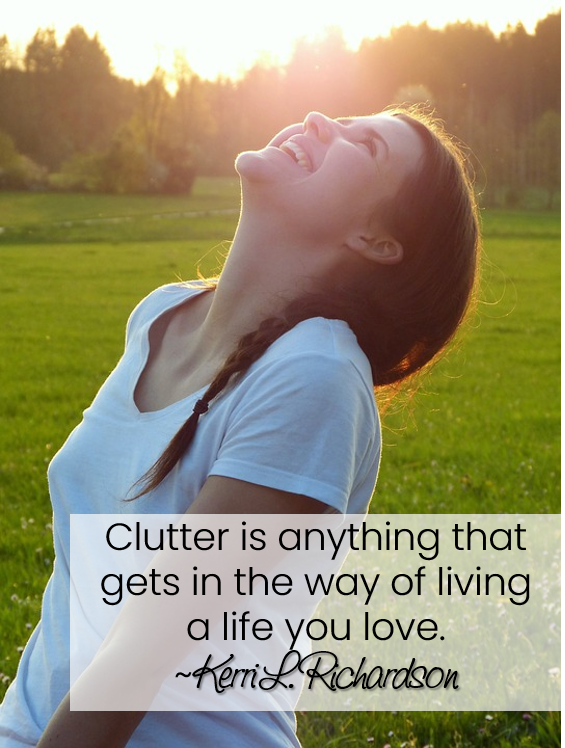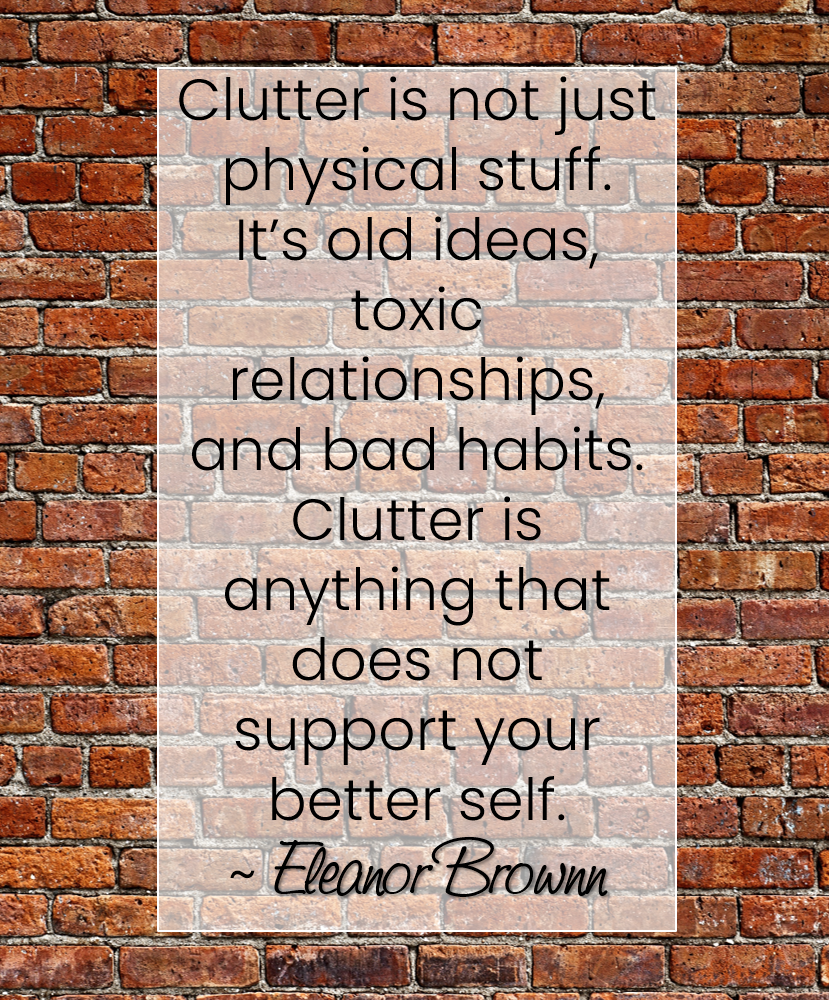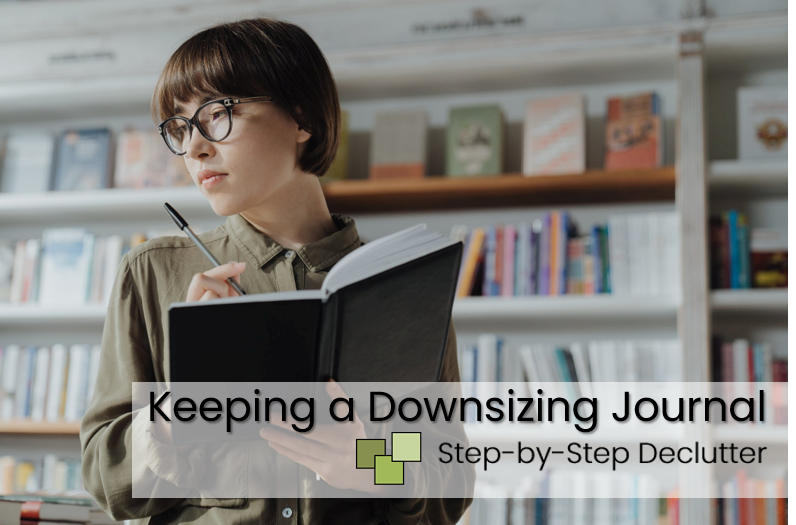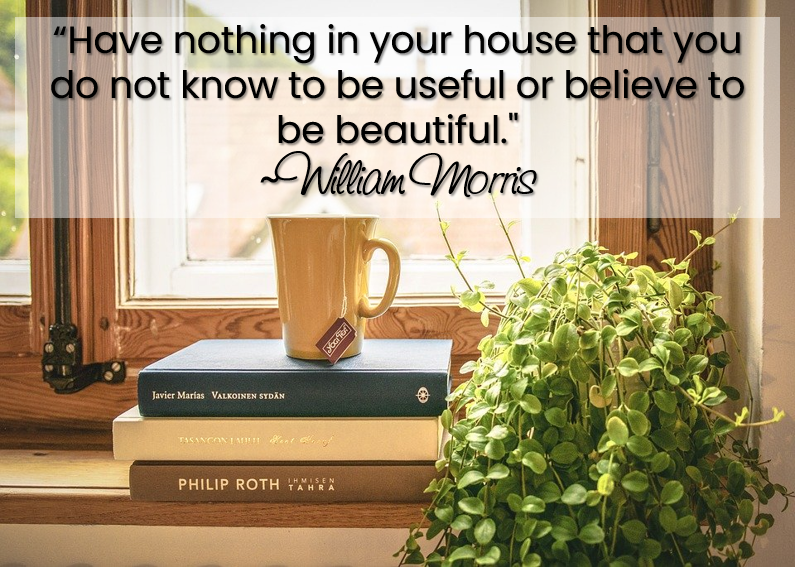|
|
|
AFFILIATE DISCLOSURE: This post contains affiliate links. This just means that there are product suggestions included within the text. Should you click on one of the links and decide to make a purchase, I will receive a small commission. I only suggest products I love and have experience with that are directly related to the content in this post. You can view my Disclosure Statement for more information. Thank you for your support! When you hear the word clutter, what comes to mind? If you're like most people, physical clutter is the thing you think of first. It may even be the only thing. In truth, though, clutter can take many forms. Kerri L. Richardson, professional organizer and author of the book What Your Clutter Is Trying To Tell You, defines clutter as follows: When thought of in this way, many other types of clutter become evident. The first step to decluttering is to uncover your clutter. In other words, to truly conquer your clutter, you have to identify it in all its forms in order to root it out and remove it from your life.
Not all clutter is visible. While visible clutter (which I will refer to as physical clutter) is the most obvious, it may not be the most limiting or the most impactful form of clutter in a person's life. Clutter can be mental, emotional, or spiritual as well. While generally unseen, these types of clutter (sometimes referred to as "baggage") can have a radical impact on quality of life and overall well-being.
The clutter that is conscious is the clutter that you recognize and acknowledge. When you encounter conscious clutter, it elicits a reaction. The reaction can be both intellectual and physical in nature. For example, seeing a cluttered countertop might cause your muscles to tense or your heartrate to increase. It might also conjur negative thoughts and emotions. While most conscious clutter is physical, not all physical clutter is conscious. It's possible for a person to become so used to physical clutter that he or she develops a sort of clutter blindness. Unconcious clutter can also evoke physical and emotional signs of stress. The difference lies in the fact that unconcious clutter is not recognized as clutter. It can be anything in your life that is getting in your way, preventing your progress, or impacting your peace and happiness. This description of clutter by inspirational writer Eleanor Brownn perfectly describes what I am referring to as unconscious clutter.
Now that we have expanded our understanding of clutter, let's take a closer look at the different kinds of clutter.
Physical clutter is stuff. It takes up space in the physical world. When searching for a definition of clutter, you will find that it is often associated with disorder, confusion, and excess. Physical clutter refers to those items that are unused, unneeded, and/or unwanted but held onto for one reason or another. It can also refer to items that are out of place or have no permanent home. It's interesting to note that the reasons behind the accumulation and retention of physical clutter could be considered a form of clutter in and of themselves. I'm thinking here of the guilt or fear that often cause us to hold onto things that really don't have a place in our lives. Clearing Away Physical Clutter: This website is dedicated largely to the concept of dealing with physical clutter, so I won't go into tremendous depth here. Instead, I will just offer a few simple suggestions for getting started.
Mental clutter accumulates when we have too much to do or to think about. As a result, our brains become overloaded making it difficult to focus, problem solve, and be productive. This leads to stress, anxiety, and frustration. If you are like me, you probably find yourself thinking most clearly during down times such as while driving, taking a shower, exercising, or laying in bed first thing in the morning. This is because these simple, semi-automatic activities require very little 'brain power', thus allowing our minds to focus in on a particular problem that's been troubling us or to suddenly wow us with a flash of brilliance or creative genius. The problem is, capturing these light bulb moments can be tricky when one is in the middle of traffic or dripping wet. The good news is, there are things we can do to recreate the circumstances that foster mental clarity. Clearing Away Mental Clutter:
Emotional clutter comes as a result of negative thoughts and feelings that weigh us down and limit our progress. Guilt, fear, anger, resentment, self-doubt, jealousy, anxiety, and grief are some of the biggest culprits. Despite their damning effect on us (or perhaps because of it), we often cling to these emotions, and the sources from which they spring, with self-destructive determination. What are the sources of emotional clutter? Some examples include:
The key to overcoming emotional clutter is to develop emotional resilience, or the ability to adjust or recover when faced with change, setbacks, disappointments, and other challenges that life presents. Clearing Away Emotional Clutter:
Integrity is often associated with honesty. That is certainly an important aspect of integrity, but there is more to this concept than mere veracity. Integrity also means whole, sound, undiminished, unimpaired. When applied to one's character, I think a good way to define integrity is living in such a way that your actions are consistent with your beliefs. In other words, integrity is being true to yourself. When we make choices that we know are not an accurate reflection of how we believe we should live our lives, our integrity is weakened. Much like a building that is structurally unsound, poor choices can leave us feeling unbalanced, out of alignment, and just off. It could be as serious as committing a crime or breaking a vow or as simple as being unkind or eating something that's bad for you. It all depends on what matters to you and the person you want to be. Whatever the case, the more we live out of sync with the things we believe to be right, the more spiritual clutter amasses in our lives. Clearing Away Spiritual Clutter:
Clutter can be overwhelming. When it comes to physical clutter, clients often tell me, "I don't know where to start." The same can be true for all forms of clutter, be it mental, emotional, or spiritual. My response to this statement is always the same, and it holds true no matter what type of clutter you are dealing with. It doesn't matter where you start. Just start, and in doing so, you will build confidence and momentum that will carry you through to the end. I wish you every success in uncovering and conquering your clutter. It is worth the effort. You can do it. I believe in you. If you're feeling nervous about uncovering your clutter, contact me. The process is always easier when you have support.
10 Comments
Recently, as I have begun to work virtually with clients, I have encouraged them to keep a downsizing journal.
A downsizing journal is exactly what it sounds like: a journal dedicated to the process of downsizing. Downsizing is a major undertaking that involves a great deal of physical, mental, and emotional effort. At times, it can be overwhelming, frustrating, and/or exhausting. Staying on track and maintaining your motivation for such an undertaking can be challenging. Writing about the experience can help you appreciate your purpose, examine your feelings, vent your frustrations, and record your progress.
You can obviously include anything you like in your downsizing journal. That's the beauty of journals; they're personal. That said, I do have a few recommendations for how to utilize a downsizing journal effectively. Consider including the following: Define Your "Why" Your "why" is your purpose for downsizing. I enthusiastically encourage you to start your journal off by creating your persoanl list of reasons for embarking on the downsizing journey. Take your time producing this list. Ponder. Ask yourself questions such as:
Record your answers. You can create a simple bullet list or write detailed paragraphs explaining each of your reasons. However you choose to record the information, it's important that you look at it frequently throughout the process. Use it as a reminder of why you started the downsizing process and a source of motivation to keep you focused and moving forward. Describe Your End State Your end state is closely related to your "why" but different enough to merit a page or two of its own. Your end state is what allows you both to visualize and to recognize success. How will you know when you have successfully downsized if you don't have a picture in your mind of what that will look like? Again, it's helpful to ask yourself a few questions and record your answers. Some questions to ponder include:
Again, it's important to revisit your answers periodically in order to evaluate your progress and be reminded of what you are working toward. Outline an Action Plan If you are working with a professional organizer, he/she can assist you in creating an overarching plan for achieving your downsizing goals. Downsizing is a comprehensive process that typically involves editing all of your possessions, at least to a certain degree. As such, it is best to break it down. I recommend taking one of the following approaches:
Creating a detailed plan for downsizing will take some time and thought, but it will make the actual process much simpler because you will know when you have met your goal. Decision making will be less stressful if you have a clear set of guidelines in place to help you determine what you want/need to keep. Record Your Progress A journal is a great place to insert before and after photographs to document your progress. You might also use your journal to make to do lists. Personally I find crossing items off a list extremely satisfying. You can also just write about your progress in typical journal format by describing what you accomplish each day or week. Vent Your Frustrations As with any major undertaking you will encounter challenges throughout the downsizing process. Things will not always go according to plan. Venting your frustrations on paper can be wonderfully theraputic. It's a way of purging your soul while purging your belongings! Work Through the Decision Making Process If you're having trouble determining what to part with or struggling to let go of things, write about it. Make a list of pros and cons for keeping or getting rid of a particular item that's causing your stress. Seeing it all laid out in black and white often yields an obvious solution. Record Your Feelings When you're feeling overwhelmed by the sheer scope and scale of the process, write it out. When you're feeling proud of what you've accomplished, record those emotions. Writing down your feelings can be an effective way of processing them. The simple act of writing it down can help you to make sense of what you're feeling and deal productively with those emotions. Write About Your Stuff Do you have fond memories of a particular item? Whether or not you are keeping the item in question, I recommend writing about it. Describe the circumstances that led you to acquire the item, who gave it to you, what you love about it, why it has value to you, and where it came from. You might even experiment with writing to the item itself. Pretend you are transcribing a letter to the beloved item. Reminisce about how you "met", who "introduced you", what kinds of experiences you enjoyed together, and so forth. Be sure to include a photograph of the item as well. Keep Track of Things We downsized as part of a recent move. For us the process involved giving away many items to friends and family, donating items to charity, and selling some items. Because I was giving away a lot of things to a lot of different people, I kept an ever-evolving list of the items I had offered up, who had claimed them, and when/where the items would be handed off to their new owners. A downsizing journal is the perfect place to keep track of such information. If you're selling a lot of things, you can also use your journal to list each item, your asking price, your rock-bottom price, and other pertinent information.
If you are embarking on the downsizing journey, I hope you will consider keeping a downsizing journal. Doing so can help you manage, process, record, and preserve the process. Your downsizing journal can be private, or you can share it with a family member or trusted friend. If you are working with an organizer, I recommend you share portions of your journal with him/her as you deem appropriate.
Downsizing has been on my mind lately. My husband and I recently downsized extensively as part of a move, I'm working with a couple of clients right now on major downsizing projects, and this past week I helped my mom downsize as she moved to a significantly smaller space. On top of that, my daughter and her family are currently downsizing to a much smaller home as part of a temporary relocation. As a result, I've put a lot of thought into the process of downsizing, how it differs from simple decluttering, and how the two processes are related. While it is impossible to downsize without decluttering, and decluttering certainly reduces the amount of stuff in a space (i.e. downsizing), in my mind there is a discernible, though perhaps subtle, distinction between the two processes. Meriam Webster defines the word declutter as follows: (verb) to remove clutter from a room, an area, etc. You will not be surprised to learn that, as an organizer, I have a fondness for decluttering. Indeed, for me it is a mindset, a way of life. I keep a bag, box, or bin for collecting items I wish to get rid of perched in a designated spot in my garage, and I regularly make trips to the thrift store to make donations. It wasn't, however, until this last move that I felt like I could say I had legitimately downsized my belongings. So what's the difference? The definition of downsize is: (verb) to reduce in size. How is this different from decluttering? The distinction, in my mind, between downsizing and decluttering centers on two factors:
Scope Let's start with scope, or extent. One can declutter, or reduce the clutter, of a surface, a drawer, a closet, a room, or an entire house. On the other hand, downsizing refers to the comprehensive reduction of one's possessions. Thus, the scope is broad and all-inclusive. When you legitimately downsize, it is with the intent of living a simpler life, one that reduces your overall footprint and requires less space. Scale Since decluttering simply involves the reduction of clutter, it can be performed on a small scale - such as thinning out a collection or getting rid of items that are no longer functional. If we wanted to get technical, getting rid of just one unwanted or unneeded item could be considered decluttering. Downsizing, on the other hand, requires a tangible change in the amount of stuff you own. When you downsize, you minimize all of your belongings typically with the intent of reducing the size of your living space. Because the scope and scale of downsizing are much broader than is generally the case with decluttering, the process can be a bit overwhelming, and it can be difficult to know where to start. Since I've had to really think this through lately, I've come up with some suggestions for how to approach the downsizing process. Define and Embrace Your LifestyleOften downsizing is motivated by a lifestyle change. It may be one that you have sought out, as was the case for us, or it may be one that is thrust upon you. Whatever the case, the first thing to do when you are faced with downsizing is to examine your situation. For example:
Thinking about potential changes to your lifestyle that may come about as a result of downsizing will help you come to terms with the process and even look forward to living with less. Instead of feeling like a burden, you can start to embrace downsizing as a means of reducing the burden of unwanted, unneeded, unused stuff. Start with the Easy StuffWhen faced with a major undertaking such as downsizing, I recommend starting with the simple stuff and working up to more challenging tasks. What is the simple stuff? In this case, I am referring to those things that are the least stressful to part with - things that have no sentimental or inherent value. Here are a few examples:
Purge Your PaperworkOne unused, often unneeded, item that people frequently hang onto is paperwork. If you are downsizing, now is the perfect time to get rid of all that excess paper. For tips on how to Declutter Papers and Files check out the Information Management section on this website. Let Your Space Be Your GuideIf you are downsizing but staying in the same place, consider how you would like your space to look and feel. If you are downsizing to a smaller space, examine the new space carefully. Take photos and measurements. Only keep those things that will fit the constraints of your space, whether literal, physical constraints, or intentional, functional constraints you have choosen to apply. Only keep the clothes that will fit comfortably within your closet and/or dresser. Only keep the books that will fit on the shelves you have for which you have space...and so forth. Practice ExclusivityThink of your space as an exclusive club - only the best of the best are allowed admission. Choose your favorites, and part with the things that are just so-so. Choose your favorite furniture, your favorite decor items, your favorite wall-hangings/photos/artwork, your favorite kitchen utensils, your favorite clothes. Imagine a space where all the things that surround you are things that you love. This quote from William Morris has always inspired me in this regard: Search for Versatile SolutionsAs you sort through your possessions for those worthy of keeping, look for items that can serve more than one function. Furniture pieces are a great example. Do you have an item that offers both seating and storage? Or a work surface as well as storage? Be RealisticIf your space is decreasing, it is important to choose items that are correctly proportioned. A queen size bed is obviously a better option for a small bedroom than a king size bed. Choose furniture with slim lines such as narrow side tables, a sleek sofa, a petite table, etc. Avoid overstuffed, bulky furniture. Consider how you will use the space as well. Do you need a separate desk, or can you function comfortably with a folding or portable desk? Or could your dining room table double as a work space? Living with LessIf your downsizing efforts are brought about by necessity, and not by choice, you may be feeling frustrated, overwhelmed, or depressed. It's normal to feel that way in such circumstances. Just know that, while changes is almost always challenging, it also brings opportunities for growth and opens the door for new experiences. Look for the positives that will result from this change of lifestyle. There will be many.
|
Archives
November 2022
Categories
All
|
Proudly powered by Weebly













 RSS Feed
RSS Feed